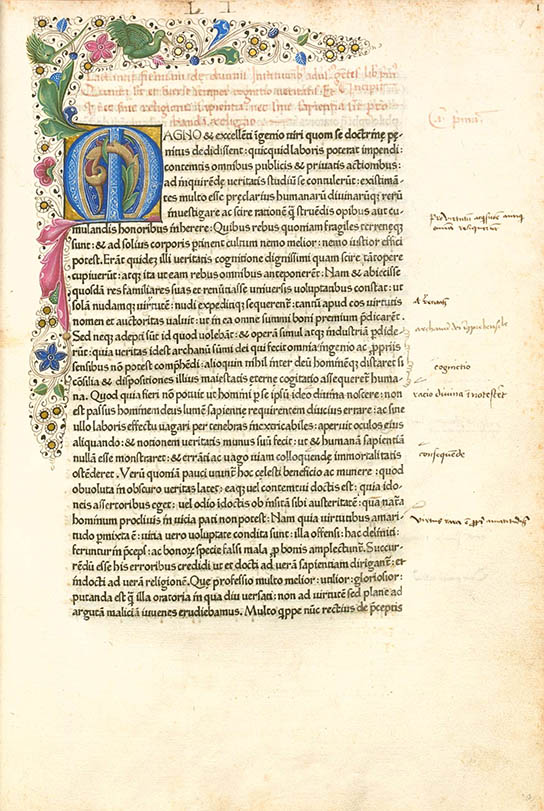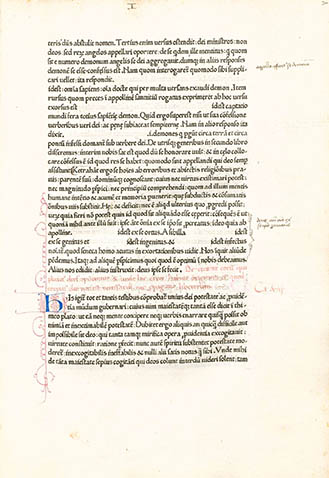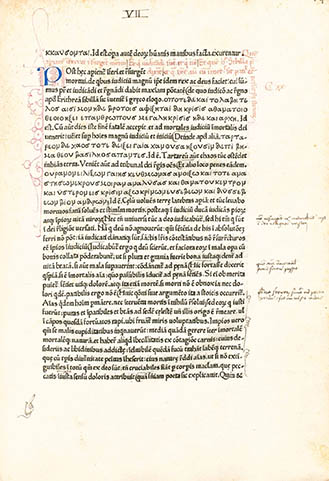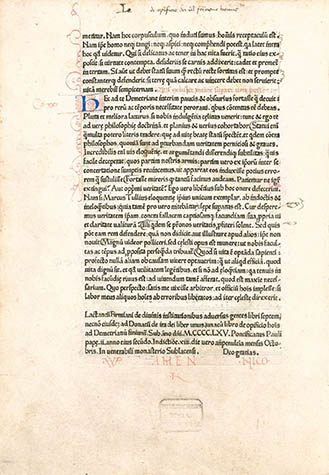112
Lactantius
Sweynheym, Pannertz and Half-Roman
Here is the first page of Sweynheym and Pannertz’s De divinis institutiones by Lactantius (the Christian Cicero).1 It was printed in Oct 1465, making it their second (or maybe third) book and the second (or third) book printed outside of Germany.
The text was printed with two types – a “half-Roman” type based on historical models and a relatively simple Greek type. The beautiful rubrication was separately applied. Sweynheym’s types represent the last stop before the true Italian Humanist Roman types introduced just a few years later.
Conrad (or Konrad) Sweynheym, a Mainz cleric and engraver, likely learned printing from either Schöffer or Gutenberg. After the Oct 1462 sack of Mainz he, along with his partner Arnold Pannartz of Cologne, joined the diaspora of printers fleeing the city and by late 1453 or early 1454 ended up at the Benedictine monastery of Santa Scholastica in Subiaco, Italy.
Exactly why they came to Subiaco is not clear. Perhaps it was by the invitation of the monastery’s abbot Cardinal Giovanni of Turrecremata or perhaps it was by the urging of the German cleric and humanist philosopher Cardinal Nicholas of Cusa. Nevertheless, once at the monastery the pair possibly printed a Donatus and certainly printed Cicero’s De oratore (Sept 1465) as well as the Lactantius and Augustine’s De civitate Dei (1467). They became the first printers outside of Germany.2
Folio 45 recto, showing space reserved for the uncompleted Greek type
Folio 140 recto, showing the Greek type
Folio 172 verso, colophon
In 1467 Sweynheym and Pannertz received an invitation from the Marquise Pieto and Francesco Massimo to move their press to the palatial Massimo estate in Rome. By November they were established and had printed their first work, Cicero’s Epistolae ad Familiares (1467). Over the next four years, with their editor Bishop John Andreas Bussi of Aleria, they printed Latin classics, the occasional ecclesiastical title, even a five-volume Bible with commentary. According to the list published in their 1472 edition of Nicolaus de Lyra’s Postilla super Bibliam they had printed 12,475 copies of 28 titles.
Although they were rather proficient at printing books they were not particularly good at selling them. In their famous petition to Pope Sixtus VI 3 (also in the 1472 de Lyra) they wrote “We brought the printing art to Rome. We battled against difficulties which other refused to meet, and as a result our money is spent, and our house is full of unsold quires, but enpty of the means of subsistance.” 4
Bishop Bussi attempted to lobby the Pope on their behalf but it was apparently unsuccessful and their partnership was dissolved in 1473. Pannartz continuing with printing and Sweynheym returned to engraving, working up to his death on a set of plates for Buckinck’s 1478 edition of Ptolemy’s Cosmographia.
For their decidedly humanist press Sweynheym cut a type based on historical Italian models. His first type (the Subiatco or Lactantius type) was based on Roman inscriptions for the uppercase (note particularly the long tail on the Q) and Carolingian miniscules and perhaps contemporary Italian calligraphy for the lowercase. The result, while not particularly harmonious, is nevertheless the last bridge between the gothic types and the pure Roman types. Type historians have termed it “half-Roman.”
Cicero, De oratore, 1465. John Rylands Library
Sweynheym cut new types when they set up their press in Rome. For the new type he refined his Lactantius lowercase and created one of the first true humanist Roman typefaces.
Lactantius, Divinae institutiones (second edition), 1468. Bayerische StaatsBiblothek
Pliny, Historia naturalis, 1470. Bayerische StaatsBiblothek
1. Lactantius, Lucius Coelius Firmianus. De divinis institutiones (AKA Opera). Subiaco, Italy: Sweynheym and Pannertz, 29 Oct 1465, (ISTC: il00001000). The book consisted of 172 (f° sized) printed folios as well as a number of blank folios.
Sweynheym had not completed cutting his Greek type when printing began and as a result at least one-third of the book includes blank spaces where the Greek text was to be printed.
2. For a wonderful interactive history of printing in Europe see the Iowa Library’s Atlas of Early Printing.
3. Pope Sixtus IV (Francesco della Rovere) was Pope from 1471 to 1484. In addition to renewing the war against the Ottoman Turks and issuing the Papal bull Exigit Sinceras Devotionis Affectus, which began the Spanish Inquisition, he was also a patron of the the arts and sciences and the Vatican Library (which, unfortunately, didn’t help Sweynheym and Pannertz). He is perhaps best remembered for the construction of a new Cappella Pontificia. The new chapel, named the Sistine after hin, was completed just a year before his death.
4. Scholderer, V. The Petition Of Sweynheym And Pannartz to Sixtus IV. Library 1915 s3-VI(22): 186–190.
8 Jan 2012 ‧ Typographia Historia






